|

Summer 2000 (8.2)
Pages
64-67
Meet Me at the
Akhundov
Baku's
Biggest Library Still Draws a Crowd
by Leyla
Gafurova, Director
Statues in the Archways - Akhundov National Library
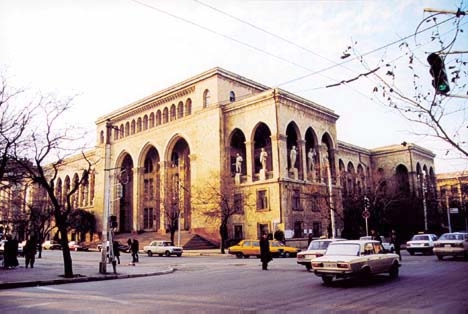
If you want to get a feel for Azerbaijanis' attitude toward literature
and education, just pay a visit to the Akhundov Library in Baku.
Outside you'll find statues of beloved poets; inside you'll find
reading rooms quite packed. It's especially refreshing to see
that Azerbaijan's largest library is popular with both younger
and older generations. For a close-up look at the library, we
talked with Leyla Gafurova, who has worked at the Akhundov for
the past 40 years and is now its Director.
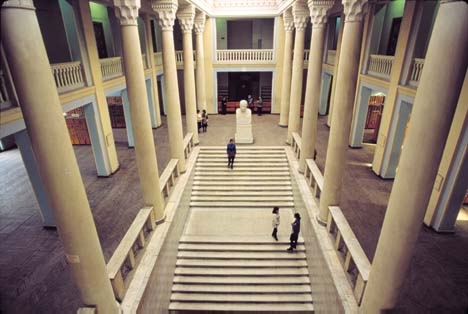
Above: Main stairway entrance
of the Akhundov National Library designed by Architect Mikayil
Useynov, completed in 1959. Photo: Blair
_____
The Akhundov Library is Azerbaijan's largest library. As the
National Library, it plays a vital role in protecting our national
literature. In total, we have about 4.5 million items, including
books and printed materials, newspapers, maps, dissertations
and records. We also house major resources and references for
scientists and historians. For instance, we're the only library
that has microfilm and photos of newspapers published in Azerbaijan
before the Bolshevik Revolution (1920). We also have copies of
all the newspapers published during the Soviet period.
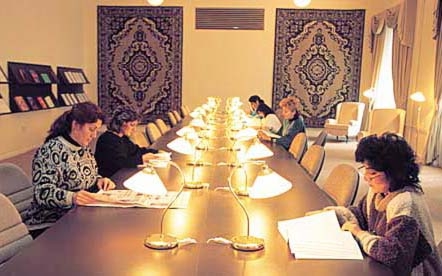
Above:
The Amoco
Technical Reading Room dedicated to Oilman Gurban Abbasov and
Amoco President Robert L. Blanton. Renovated in 1994 by Amoco.
New Alphabet, New
Library
Earlier this century, there was no major library in our country.
This particular library officially opened May 23, 1923 and was
first known as the General Library and State Book Storage of
Azerbaijan. That was the same year that Azerbaijan officially
adopted the Latin alphabet as its second official national script
along with the Arabic alphabet. At that time, the library was
located inside what is now the Presidium of the Academy of Sciences.
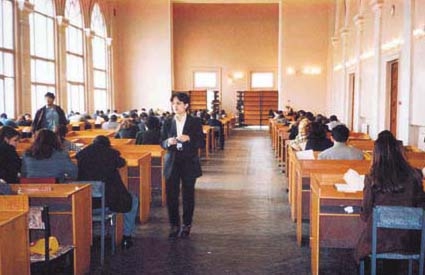
Above: Inside the readings
rooms of Akhundov National Library. Books are not permitted to
be taken from the library.
On July 11, 1939 [at the height of Stalin's Repressions], the
library was renamed after Mirza Fatali Akhundov (1812-1878),
a writer who is credited with starting the theater tradition
in Azerbaijan in the mid-19th century. Akhundov was also very
active in alphabet reform and tried to modify the Arabic script
so that it would adequately reflect the sound system of Azeri.
When Arabic script reform did not catch on, Akhundov went on
to propose a Latin-Cyrillic based alphabet to replace Arabic.
His recommended script was never adopted but it helped set the
wheels in motion for us to eventually adopt the Latin alphabet
that we have today [See "Mirza
Fatali Akhundov, Alphabet Reformer Before His Time" by Farid Alakbarov,
AI 8.1, Spring 2000, page 53].
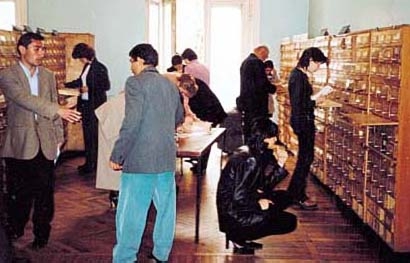
Above: Card catalogs still
provide the main index to the library's collection. Hopefully,
in the not-to-distant future, the system can be computerized.
Complicating the issue is that books in Azeri are written in
three different scripts - Arabic, Cyrillic and Latin.
In 1959, this building was finished and we moved in. Its location
is prime - not only in terms of being in the center of the city
but also from a cultural point of view. Next to it on Khagani
Street, there's the National Opera and Ballet Theater, which
is across from the Theater of Young Spectators. The entrance
to the library overlooks a garden park. We are also close to
various institutes, including the National Pedagogical Institute,
the Music Academy, the Institute of Foreign Languages and the
Oil Academy.
Acquisitions
Here at the Akhundov, we have tried to gather every possible
text that is written in the Azeri language. According to the
Law on Library, we receive four copies of all new books and two
copies of all magazines and newspapers that are published in
Azerbaijan.
During the Soviet Period, we were also required to gather copies
of all books published in Russian in the Soviet Union. We received
these for free - close to 110,000 new publications (books, newspapers
and magazines) each year. At that time, all of the major libraries
in the Soviet Union were like duplicates of each other. They
all had the same assortment of books with the exception that
each Republic had its own separate national collection as well.
We also exchanged books with other Republics, mostly with Russia.
We used to send books published in Azeri to the former Lenin
Library in Moscow, and they sent us books in exchange. This tradition
still continues, but these days we receive fewer and fewer books.
Two to three times a year, one of our staff goes to Moscow and
chooses titles that we want. Once he brought back 1,000 publications;
another time, 4,000. We are eager to get books in fields like
management, economics, politics and law.
During the Soviet Period, it was difficult to exchange books
with foreign countries. In 1962, we finally were granted permission
to create exchange ties with the National French Library. We
were only able to send them books that the KGB approved. We also
have had good relations with the U.S. Library of Congress. When
the Soviet Union collapsed, they were the first library to send
representatives to build relations with us again.
Today we receive books from other countries, but we don't have
money to buy as many books as we would like. Sometimes Soros
Foundation and other organizations sponsor publishing projects.
Exxon has published books like the 5-volume "Children's
Encyclopedia" and the English-Azerbaijani dictionary (Cyrillic
and Latin versions).
We also receive publications from the Organization for the Security
and Cooperation of Europe (OSCE), the European Bank of Reconstruction
and Development (EBRD) and various embassies in Azerbaijan. For
example, the Italian Embassy donated 240 books a few years ago.
We also receive many books from the French and Israeli embassies.
In addition, we receive books and newspapers in the Persian language
from the Cultural Center of the Iranian Embassy. During the Soviet
Period, we were not allowed to receive any books from Iran or
Turkey.
Striking Architecture
While most people visit the Akhundov Library for its extensive
collection of materials, some come to see its fascinating architecture.
Actually, this is one of the most interesting classic-style buildings
designed by Mikayil Useynov. [For more information on Useynov,
see "The Soviet Period of Architecture in Azerbaijan: The Twists and Turns of the Career of Mikayil
Useynov (1905-1992)" by Ilham Aliyev, in AI 6.4, Winter
1998, page 46.] This building fuses 20th-century architectural
elements with Azerbaijan's rich traditional styles. You can see
this particularly in the use of arches and columns and in the
balcony porticos, which feature statues of our most distinguished
writers and cultural figures.
Reading Rooms
The Akhundov is a very busy library. Often, its 13 reading rooms
are filled with students and other visitors. Unfortunately, over
the years, some of these rooms have become quite run down. Amoco
was one of the first companies to respond to our request for
help; it helped us refurbish the hall of Foreign Literature in
1995. Another reading room, sponsored by the Turkish Embassy
(1998), is dedicated to newspapers and magazines. In addition,
the Iranian Embassy has sponsored an Exhibition Hall (1997).
The Amoco Technical Reading Room is named after Gurban Abbasov
and Robert L. Blanton. Abbasov became a legendary figure in Azerbaijan's
oil industry after the development of Oil Rocks, the world's
first offshore drilling project, in 1949. Robert L. Blanton was
President of Amoco Caspian Sea Petroleum when Amoco became established
in Azerbaijan in the early 1990s. Both were present at the opening
library ceremonies in Baku in 1994.
This hall contains computers and software to catalog and track
new materials along with more than 350 books and hundreds of
English-language journals from Blanton's personal library. These
texts cover instrumentation, geology, geophysics, engineering,
safety and fire protection.
We don't permit books to be checked out or for people to take
them home; they have to read them at the library. The process
is as follows: Patrons search for a book in the card catalog,
then write down the book's title and call number. A librarian
goes to look for the book in the collection, which may take about
30 minutes. Requests can be made for librarians to reserve the
books for the following day.
Rare Books
The Akhundov has a unique collection of historical works, called
the "Azerbaijan Book" section. It includes approximately
72,000 volumes and microfilms kept of everything that we have
succeeded in collecting that has been published in Azeri, regardless
of time, place or alphabet.
Titles include "Divan" by Fuzuli (Tabriz, 1849), "Divan"
by Ajiz (Tabriz, 1857), "Tamsilat" by Akhundov (Tiflis,
1859), an Azeri translation of Shakespeare's "Othello"
(Baku, 1893) and "First Winemaker" by Leo Tolstoy (Baku,
1896). There is also a fine collection of issues from the satirical
magazine "Molla Nasraddin" (1906-1932).
All rare books are kept in storage in the "Azerbaijan Book"
section. Scholars who are doing research or writing dissertations
can come and use the books, but of course cannot take them home.
Musical Scores
In our music section, there are approximately 175,000 items including
musical scores, books, magazines and journals related to music.
For listening, we have vinyl discs and tapes.
Foreign Collection
We also have a department of foreign literature where readers
can find books, newspapers and magazines in foreign languages.
There are about 313,900 books in English, French, German, Turkish,
Persian, Spanish and other languages.
The Foreign Collection contains treasures like "Dada Gorgud"
in English translation (London, 1972). Nizami's poems are also
featured in translation, including "Khosrov and Shirin"
in French (Paris, 1970) and "Seven Beauties" (Yeddi
Gozal) in Italian (Milan, 1967).
Recent Events
Presentations and meetings are usually held in the Exhibition
Hall. The latest exhibition was devoted to the 1,300th Jubilee
of Dada Gorgud on April 7, 2000. The exhibition featured literature
about Dada Gorgud, including a two-volume encyclopedia about
the Turkic epic, an enormous project that was edited by Anar,
President of Azerbaijan's Writers' Union.
The first volume of the encyclopedia includes the versions of
the Dada Gorgud manuscripts that are kept in Dresden and the
Vatican. The second volume covers exhibits related to Dada Gorgud
that are found in Azerbaijani museums. This encyclopedia was
sponsored by the Ministry of Culture, the Academy of Sciences,
the Writers' Union and the Ministry of Education.
Several other books were on display during the exhibition. They
included "Dada Gorgud Dunyasi" (The World of Dada Gorgud)
by Anar as well as V. Bartold's second edition of "My Grandfather
Gorgud's Book", written in Russian.
On February 9th this year, LUKOIL and the Soros Foundation presented
the library with 400 books, covering various subjects such as
science, law, philosophy, economics and history. All of the books
were published in Moscow.
Internet Access
In late May we plan to have the opening ceremony of the library's
Internet Unity section. This project is being implemented by
the Eurasian Fund. This section will have seven computers connected
to Internet so that Azerbaijani readers can gain access to world
databases.
We're dreaming of the day when we will be able to computerize
our card catalog, as this would be a tremendous boost to research
and save time for those who spend hours looking for sources in
card catalogs.
Akhundov
Library
29 Khagani Street, close to the Sahil Metro Station
Hours: Tuesday to Sunday, 10 a.m. to 8 p.m. Closed Mondays.
Leyla Gafurova is the Director of
the National Akhundov Library in Baku. For her concerns about
the new Latin alphabet, see "On the Street: Viewpoints about Alphabet Transition", AI 8.1, Spring
2000, page 27. Gafurova was interviewed by Farida Sadikhova.
From Azerbaijan
International
(8.2) Summer 2000.
© Azerbaijan International 2000. All rights reserved.
Back to Index
AI 8.2 (Summer 2000)
AI Home
| Magazine Choice | Topics
| Store
| Contact
us
|





